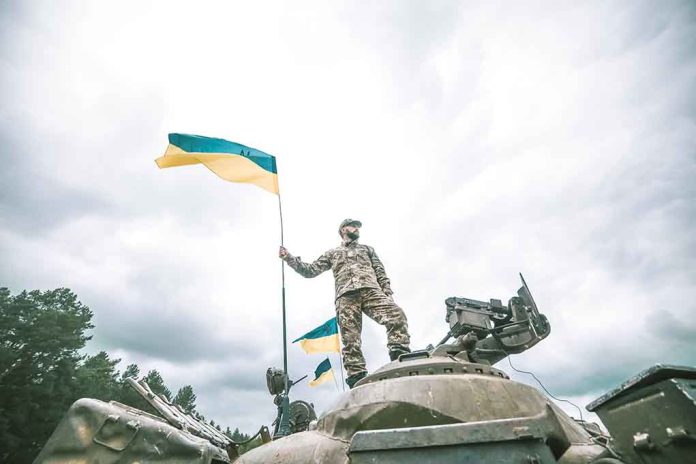
Ukraine’s ingenious use of homemade drones against Russian warplanes has revolutionized modern warfare while Putin’s economy teeters on the brink of collapse with crushing 21% interest rates and rampant inflation.
Key Takeaways
- Ukraine’s Operation Spider’s Web successfully damaged Russian strategic aircraft using inexpensive homemade drones, demonstrating their ability to strike deep within Russia
- Russia’s economy is sliding toward recession with growth plummeting to 1.4% in Q1 2025 and inflation more than double the central bank’s 4% target
- The Russian central bank has been forced to maintain interest rates at 20%, after reaching 21% in October 2024, severely restricting economic activity
- Ukraine continues to face security challenges with new drone attacks on Kharkiv and Odesa, while safety concerns persist at the idle Zaporizhzhia nuclear plant
- Denmark has promised to advocate for Ukraine’s EU accession despite Hungary’s objections, as Zelenskyy calls for intensified sanctions against Russia
Ukraine’s Drone Innovation Reshapes Battlefield Dynamics
Ukraine’s military operation against Russian warplanes, dubbed “Operation Spider’s Web,” has marked a significant turning point in modern warfare. The attack successfully damaged or destroyed multiple Russian strategic aircraft, including those capable of carrying nuclear weapons, by utilizing domestically produced drones that cost a fraction of traditional military hardware. This asymmetric approach has proven remarkably effective, enabling Ukraine to strike high-value targets deep within Russian territory despite being the smaller military power in the conflict.
“I think the most significant thing is that it showed Ukraine’s ability to reach deep into Russia and to hit targets that have a very high level of strategic significance,” said Eric Rosenbach, co-director of the Harvard Kennedy School’s Belfer Center for Science and International Affairs.
The operation showcased Ukraine’s sophisticated planning capabilities, including advanced intelligence gathering and the ability to smuggle drone components across borders. What began as a program using modified commercial drones has evolved into a robust domestic production network with global supply chains. Military strategists worldwide, particularly in Taiwan, are studying these tactics for potential applications against larger adversaries, raising serious questions about traditional military superiority in the drone age.
Russia’s Economy Faces Recession As War Costs Mount
Russia’s Economy Minister Maxim Reshetnikov delivered a stark assessment of the nation’s economic prospects at a recent economic showcase, admitting the country stands “on the verge” of recession. Despite earlier projections that Russia’s economy would withstand Western sanctions, growth has slowed dramatically to just 1.4% year-on-year in the first quarter of 2025 – the lowest rate in two years. The economic slowdown comes despite massive defense spending that temporarily masked structural weaknesses.
“The numbers indicate cooling, but all our numbers are like a rearview mirror. Judging by the way businesses currently feel and the indicators, we are already, it seems to me, on the brink of going into a recession,” said Maxim Reshetnikov, Economy Minister.
The Russian central bank has been forced to maintain interest rates at a crippling 20%, after reaching 21% in October 2024, in a desperate attempt to control inflation that’s now running at more than double the bank’s 4% target. While war-related manufacturing has kept unemployment low and temporarily boosted wages, economists warn the militarized economy is fundamentally unsustainable. The lack of foreign investment and concentration on defense spending has starved civilian sectors, setting the stage for potential long-term stagnation.
Ukraine’s Persistent Security Challenges
Even as Ukraine celebrates strategic successes with its drone program, the nation continues to face relentless security threats. Recent Russian drone attacks have targeted the northeastern city of Kharkiv and the southern port of Odesa, causing significant damage to civilian infrastructure and disrupting daily life. These attacks highlight the ongoing threat despite Ukraine’s tactical innovations, with civilians bearing the brunt of Russia’s military aggression as the conflict extends well beyond traditional frontlines.
The Zaporizhzhia nuclear power plant remains a serious concern, with UN nuclear inspectors confirming the facility cannot safely operate during the ongoing conflict due to unstable cooling water and electricity supplies. Despite these challenges, humanitarian efforts continue, with both nations recently completing another exchange of captured soldiers. “Our people are returning home from Russian captivity,” stated President Volodymyr Zelenskyy, highlighting one of the few areas where cooperation persists amid the broader conflict.
International Support and Future Outlook
President Zelenskyy continues to press for stronger international sanctions against Russia, particularly highlighting Moscow’s reliance on Iranian drones and North Korean munitions. These alliances between adversarial regimes represent a concerning development for Western security interests. Meanwhile, some Ukrainian officials worry that global attention may shift away from their conflict as tensions escalate between Israel and Iran, potentially giving Russia breathing room despite its economic troubles.
“Yes. I think it’s important to look at the sophistication of the Ukrainian drone program and how it has evolved,” said Eric Rosenbach, describing the broader implications of Ukraine’s military innovation.
On the diplomatic front, Denmark has committed to continuing preparation for Ukraine’s eventual EU membership as it assumes the EU Council presidency, despite Hungary’s persistent objections. This support represents an important lifeline for Ukraine’s post-war reconstruction plans, which will require substantial European integration to succeed. While Ukraine has demonstrated remarkable resilience through innovative warfare and diplomatic outreach, the path forward remains fraught with both military and economic challenges that will test the nation’s resolve and international support network.





